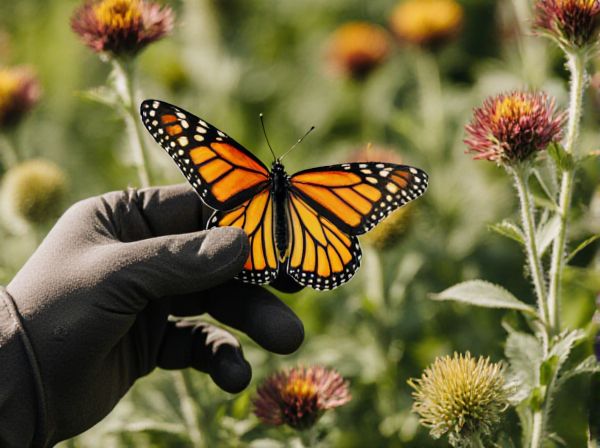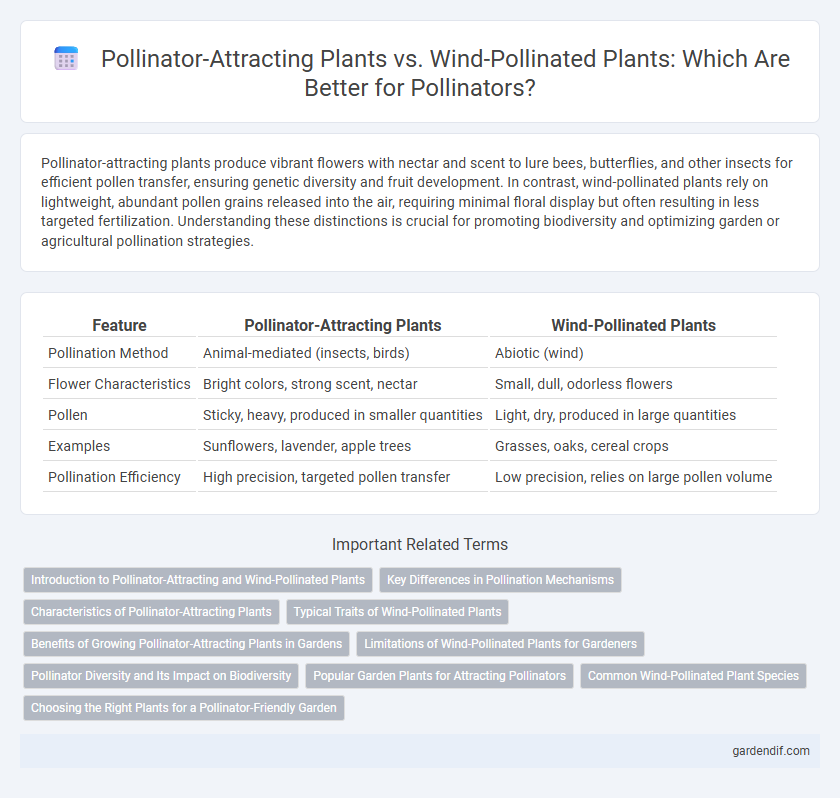
Pollinator-attracting plants vs Wind-pollinated plants Illustration
Pollinator-attracting plants produce vibrant flowers with nectar and scent to lure bees, butterflies, and other insects for efficient pollen transfer, ensuring genetic diversity and fruit development. In contrast, wind-pollinated plants rely on lightweight, abundant pollen grains released into the air, requiring minimal floral display but often resulting in less targeted fertilization. Understanding these distinctions is crucial for promoting biodiversity and optimizing garden or agricultural pollination strategies.
Table of Comparison
| Feature | Pollinator-Attracting Plants | Wind-Pollinated Plants |
|---|---|---|
| Pollination Method | Animal-mediated (insects, birds) | Abiotic (wind) |
| Flower Characteristics | Bright colors, strong scent, nectar | Small, dull, odorless flowers |
| Pollen | Sticky, heavy, produced in smaller quantities | Light, dry, produced in large quantities |
| Examples | Sunflowers, lavender, apple trees | Grasses, oaks, cereal crops |
| Pollination Efficiency | High precision, targeted pollen transfer | Low precision, relies on large pollen volume |
Introduction to Pollinator-Attracting and Wind-Pollinated Plants
Pollinator-attracting plants, such as flowering species like sunflowers and lavender, rely on insects, birds, or bats to transfer pollen, featuring bright colors, sweet scents, and nectar to lure their pollinators. In contrast, wind-pollinated plants like grasses and many trees produce lightweight, abundant pollen grains designed to be carried by the wind, often lacking showy flowers or scent since they do not need to attract pollinators. Understanding these distinct reproductive strategies highlights the ecological adaptations that optimize plant fertilization in different environments.
Key Differences in Pollination Mechanisms
Pollinator-attracting plants rely on visual cues, nectar, and scent to entice animals such as bees, butterflies, and birds, ensuring targeted pollen transfer that enhances genetic diversity. In contrast, wind-pollinated plants produce lightweight, abundant pollen grains that are dispersed passively through the air to reach stigmas without animal intervention. The dependency on biotic vectors in pollinator-attracting plants leads to specialized flower structures, whereas wind-pollinated species exhibit reduced floral traits optimized for efficient airborne pollen distribution.
Characteristics of Pollinator-Attracting Plants
Pollinator-attracting plants typically exhibit brightly colored flowers, strong fragrances, and nectar production, which serve as key features to entice bees, butterflies, and hummingbirds. These plants often have specialized floral structures like landing platforms and tubular shapes that facilitate efficient pollen transfer by specific pollinators. Unlike wind-pollinated plants, they invest energy in visual and olfactory signals to maximize reproductive success through biotic vectors.
Typical Traits of Wind-Pollinated Plants
Wind-pollinated plants typically exhibit small, inconspicuous flowers without bright colors or strong scents, as they do not need to attract pollinators like bees or butterflies. These plants produce large quantities of lightweight, dry pollen adapted for dispersal by the wind. Common examples include grasses, many trees such as oaks and pines, and sediment-tolerant plants thriving in open or windy environments.
Benefits of Growing Pollinator-Attracting Plants in Gardens
Pollinator-attracting plants such as lavender, coneflowers, and milkweed enhance garden biodiversity by supporting bees, butterflies, and other essential pollinators, which improves fruit and vegetable yields through effective cross-pollination. These plants contribute to ecosystem stability and increase resilience against pests by fostering natural predator-prey relationships. In contrast, wind-pollinated plants like grasses and many trees rely on passive pollen dispersal, offering limited benefits for pollinator populations and garden ecosystem health.
Limitations of Wind-Pollinated Plants for Gardeners
Wind-pollinated plants often produce excessive amounts of pollen, leading to potential allergenic issues and reduced garden enjoyment. These plants lack vibrant flowers or nectar, providing minimal attraction for beneficial pollinators such as bees and butterflies, which can limit biodiversity in garden ecosystems. Gardeners face challenges in controlling pollination patterns with wind-pollinated species, increasing the risk of cross-pollination and hybridization in mixed plantings.
Pollinator Diversity and Its Impact on Biodiversity
Pollinator-attracting plants support a higher pollinator diversity by providing nectar, pollen, and suitable habitats crucial for various insect species, which enhances ecosystem resilience and genetic diversity. Wind-pollinated plants rely on abiotic factors for reproduction, often resulting in less specialized pollinator interactions and lower species diversity within habitats. Increased pollinator diversity from entomophilous plants directly influences plant biodiversity, improving ecosystem stability and productivity across multiple trophic levels.
Popular Garden Plants for Attracting Pollinators
Popular garden plants for attracting pollinators include milkweed, coneflowers, and lavender, which offer vibrant colors and nectar essential for bees, butterflies, and hummingbirds. In contrast, wind-pollinated plants such as grasses and many trees produce less conspicuous flowers without nectar, relying on pollen dispersal by wind rather than animal visitors. Choosing insect-friendly plants enhances biodiversity and supports pollinator populations crucial for ecosystem health and crop production.
Common Wind-Pollinated Plant Species
Common wind-pollinated plant species such as grasses, oaks, and pines rely on the dispersal of lightweight pollen grains carried by air currents to fertilize distant flowers. These plants typically produce large quantities of pollen to increase the likelihood of successful pollination, unlike pollinator-attracting plants which invest energy in colorful petals and nectar production to lure insects or birds. The evolutionary adaptation to wind pollination reduces dependence on biotic agents but requires open habitats and specific environmental conditions to maximize pollen distribution.
Choosing the Right Plants for a Pollinator-Friendly Garden
Pollinator-attracting plants, such as lavender, coneflowers, and milkweed, provide nectar and pollen essential for bees, butterflies, and hummingbirds, enhancing biodiversity and garden productivity. Wind-pollinated plants like grasses and many trees release lightweight pollen to the air but offer minimal nutritional resources for pollinators, making them less effective for supporting pollinator populations. Selecting diverse, native flowering plants with vibrant colors, strong scents, and staggered bloom times optimizes habitat for pollinators and promotes ecological balance in a pollinator-friendly garden.
Pollinator-attracting plants vs Wind-pollinated plants Infographic

 gardendif.com
gardendif.com